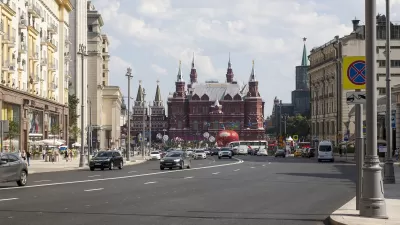Two commuter trains traveling toward each other on a single track crashed in the Puglia region of southern Italy on Tuesday morning. Human error is suspected. The trains and track lacked automatic train control and automatic braking.
Total fatalities won't be determined until a crane can pull the cars apart. Other media outlets report that 23, not 25, had died. Forty-three people were injured. Each train had four passenger cars, but only one rail car was left standing. The trains were estimated to have been traveling at 56 m.p.h. at the time of impact.
The BBC video shows an aerial sight of the crash. It's difficult to even detect some of the rail cars among the wreckage.
"Prime Minister Matteo Renzi sent the infrastructure and transportation minister, Graziano Delrio, and the head of the civil protection agency, Fabrizio Curcio, who oversees emergency response in Italy, to the site of the crash," reports Gaia Pianigiani from Rome for The New York Times.
The circumstances that led to the collision were unclear. A team of inspectors from the transportation ministry will work with local prosecutors to determine the cause, officials said.
Lack of automatic braking or automatic train control
Stefania Gnesi, an information technology staff researcher at the National Research Council, said that the trains were probably operating on instructions from dispatchers. “It’s probable that there was some human error in this chain, in a section of train track that has no automatic control or automatic brake system,” she said.
Automatic systems are used on most of Italy’s railway lines, but have not yet been installed in some areas, especially in southern Italy, which is less developed and less prosperous than the north.
The crash is the most deadly since June 2009 when a 14-car freight train carrying liquefied petroleum gas derailed and exploded near Tuscany, ultimately killing 32 people.
Deadly Amtrak derailment in May 2015
Similar issues regarding automatic braking were raised in a May 2015 Amtrak derailment in Philadelphia that left eight dead.. The Federal Railroad Administration ordered Amtrak to install automatic train control on northbound trains in the Northeast Corridor that is already working for southbound trains, notes a later post.
According to CNN, "(t)he system notifies an engineer if a train is speeding and applies the brakes automatically if the engineer does not respond. Amtrak is in the process of installing a sharper technology known as Positive Train Control (PTC) on all of its tracks."
The National Transportation Safety Board determined a year after the derailment that human error was the cause of the derailment, specifically resulting from the "loss of situational awareness by the train’s engineer after his attention was diverted to an emergency involving another train."
Head-on crash in Germany in February
A similar head-on crash on a single track occurred on February 9 in Germany, leaving 10 dead. Human error was to blame. After an investigation, it was determined that the dispatcher was "playing a game on his cellphone until just before the accident," reported Alison Smale for The New York Times in April. Unlike the Italian crash, the trains and track were fitted with automatic braking.
That crash raised "new questions about the safety and reliability of a rail network in Europe that has been the envy of much of the world, reported Melissa Eddy for The New York Times in February, adding that "crashes across Europe in recent years have highlighted weaknesses in the rail network." Eddy later wrote that "the German news media have reported that the [automatic braking] system had been turned off at the time of the crash."
FULL STORY: Train Crash in Italy Leaves at Least 25 Dead and Dozens Injured

Depopulation Patterns Get Weird
A recent ranking of “declining” cities heavily features some of the most expensive cities in the country — including New York City and a half-dozen in the San Francisco Bay Area.

Pennsylvania Mall Conversion Bill Passes House
If passed, the bill would promote the adaptive reuse of defunct commercial buildings.

California Exodus: Population Drops Below 39 Million
Never mind the 40 million that demographers predicted the Golden State would reach by 2018. The state's population dipped below 39 million to 38.965 million last July, according to Census data released in March, the lowest since 2015.

Google Maps Introduces New Transit, EV Features
It will now be easier to find electric car charging stations and transit options.

Ohio Lawmakers Propose Incentivizing Housing Production
A proposed bill would take a carrot approach to stimulating housing production through a grant program that would reward cities that implement pro-housing policies.

Chicago Awarded $2M Reconnecting Communities Grant
Community advocates say the city’s plan may not do enough to reverse the negative impacts of a major expressway.
City of Costa Mesa
Licking County
Barrett Planning Group LLC
HUD's Office of Policy Development and Research
Mpact Transit + Community
HUD's Office of Policy Development and Research
City of Universal City TX
ULI Northwest Arkansas
Town of Zionsville
Urban Design for Planners 1: Software Tools
This six-course series explores essential urban design concepts using open source software and equips planners with the tools they need to participate fully in the urban design process.
Planning for Universal Design
Learn the tools for implementing Universal Design in planning regulations.


























